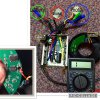joseph Jerome E. Sanchez
- Sep 17, 2018
- 13
- Joined
- Sep 17, 2018
- Messages
- 13
Hello good evening everyone,
I`m hoping to find help from this thread. My son`s pedal assist bike has stopped working and upon inspection, we found 3 wires unsoldered from the crank and when we open it, there`s no way for me to figure out how to solder. This bike is very important to him since he uses it to go from our home to his school. Please note I don`t have knowledge in electronics just know how to solder. I don`t even have a tester right now but willing to buy one but doesn`t know how to use it (but willing to learn just don`t know where to start). My son and I are hoping it`s an easy fix so we appreciate any help you guys can give us. Attached here are the pictures of the said board.
Thank you so much.
Your`s truly,
Joseph Jerome







I`m hoping to find help from this thread. My son`s pedal assist bike has stopped working and upon inspection, we found 3 wires unsoldered from the crank and when we open it, there`s no way for me to figure out how to solder. This bike is very important to him since he uses it to go from our home to his school. Please note I don`t have knowledge in electronics just know how to solder. I don`t even have a tester right now but willing to buy one but doesn`t know how to use it (but willing to learn just don`t know where to start). My son and I are hoping it`s an easy fix so we appreciate any help you guys can give us. Attached here are the pictures of the said board.
Thank you so much.
Your`s truly,
Joseph Jerome























